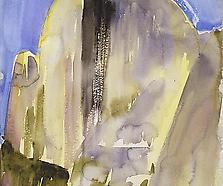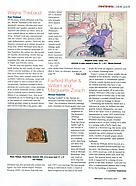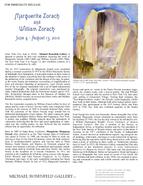“My greatest ability lies in the awareness and use of relationship of form, vision and imagination . . . I have a sensitive appreciation and ability to handle color. I feel complete freedom to take any liberties with form and space. You may find the application of my work overpowering; it is never too much for me . . . It is my pleasure and excitement to fill every space with interest and intricate weaving and design. Without this interest I would never do embroideries.” (1)
Born in 1887 in Santa Rosa, California, Marguerite Thompson Zorach often referred to as the "first woman artist of California" was raised in Fresno. In 1908, she traveled to Paris to study art, arriving in time for the Salon d’Automne, where the bold compositions of postimpressionist painters and fauvists such as Henri Matisse, André Derain, and Maurice de Vlaminck amazed her. Zorach soon became a disciple of modernism and regularly attended the salons held by Gertrude Stein and Alice Toklas. She studied briefly at the Académie de la Grande Chaumière, but dropped out when she found the curriculum too conservative. In 1911, she enrolled at the Académie de la Palette, taking courses with Jacques-Emile Blanche and John Duncan Fergusson, a leading artist of the Scottish colorist school. Unlike the other Parisian academies at the time, La Palette was not traditionally structured. Students had more freedom to engage in their own artistic inclinations. Zorach embraced La Palette’s progressive programming, and absorbed the modernist practices of her mentors. She was particularly captivated by the vibrant color and bold brushstrokes of fauvism, and she began to apply these methods to her own work.
At La Palette, Marguerite Thompson met many of the early modern artists including her future husband, William Zorach, who was impressed with her confidence as an artist, finding it hard to believe that “such a nice girl could paint such wild pictures.”(2) But her interest in “such wild pictures” enabled her to help William overcome the academic tendencies in his art. In July of 1912, Marguerite returned to Fresno and spent six weeks camping in the Sierra Nevada mountain range, where she created works with a fauvist palette. She and William Zorach were married after his arrival to New York City that same year, settling in Greenwich Village. Naming their residence the “Post-Impressionistic studio”, the Zorachs would frequently exhibit their work at their home. Although both artist lacked gallery representation, they participated in the 1913 Armory Show, and from 1915 to 1918, they both also exhibited regularly at the Daniel Gallery.
Marguerite Zorach (1887-1968)
Exhibitions
New & Noteworthy
Artist Information
During the early years of the Zorach marriage, their home became a meeting place for the artistic bohemian community in New York. Writers and artists would meet to discuss the latest trends in art and literature. Poet Marianne Moore wrote of the Zorachs, “I had met her [Marguerite] and William in 1916, also William Carlos Williams, Marsden Hartley and others—admired Marguerite Zorach’s paintings and embroideries greatly;…In 1916 and adjoining years I was exhilarated to be among real ‘artists…’” (3).
Even though her work was frequently shown alongside that of her husband, Marguerite Zorach remained an independent artist from her husband. In 1916, she was the only woman to be included in critic Willard Huntington Wright’s Forum Exhibition of Modern American Painters. She was a member of the Society of Independent Artists, a founding member and the first president of the New York Society of Women Artists, and active in the Salon of America.
In the 1917 exhibition of the Society of Independent Artists, Zorach showed an embroidered tapestry rug alongside her oil paints. Afterwards, she began to work extensively in tapestry, finding that she could make them “in the time between caring for two small children . . . and they sold. In one 1918 exhibition, she made twelve hundred dollars in sales, and the tapestries became a primary source of family income.”(4) Knowing that her tapestries risked being dismissed as craft, Zorach made a point of referring to these works as “modernistic pictures done in wool” In 1923, the Montross Gallery mounted her first solo exhibition of her modernist pictures in wool, Embroidered Tapestries by Marguerite Zorach. That same year, she purchased a farmhouse in Robinhood, Maine on Georgetown Island and began a series of lithographs that were based on scenes of her family life with William and their children. In the 1930s, she returned to painting and continued to create and exhibit artwork until her death in June 1968.
Today Marguerite Zorach's work is recognized in numerous Museum collections across the United States including the Museum of Fine Arts, Boston, the Farnsworth Art Museum, the Metropolitan Museum of Art, the National Museum of Women in the Arts, and the Whitney Museum of American Art.
(1) Marguerite Zorach, “The Artist’s Statement,” William & Marguerite Zorach. http://www.exitfive.com/zorach/marguerite.html. Accessed May 2010.
(2) “William Zorach, A Retrospective Exhibition of Sculpture,” 1950, reel ND43:#238, Downtown Records. Quoted in Kirsten Swinth, Painting Professionals: Women Artists and the Development of Modern American Art 1870-1930 (Chapel Hill, NC: UNC Press, 2001), 173.
(3) Burk, Efram L., “The Graphite Art of Marguerite Thompson Zorach,” Woman’s Art Journal, vol. 25, no. 1 (Spring/Summer 2004), 13.
(4) Swinth, 188.



